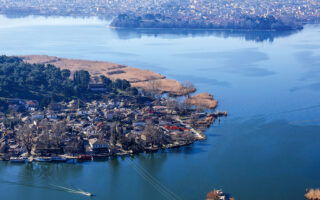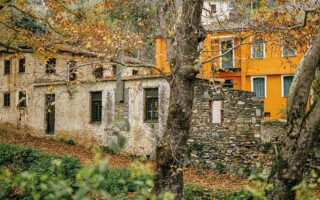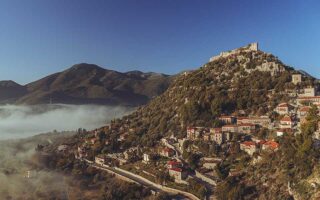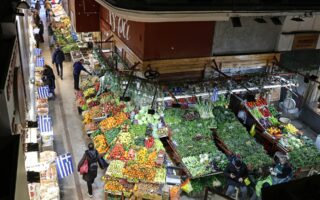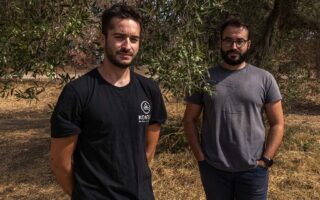As the sun rises behind the mountains, its light bathes the waters of the twin lakes in the Prespes National Park, on Greece’s border with North Macedonia and Albania, creating a breathtaking sight. Flocks of silver pelicans, cormorants, cranes and other birds flit about, emerging from their nests in the reeds in search of food. In their own kingdom, bears, wolves and wild goats roam the surrounding wooded slopes, while on the plain the locals go about their daily activities – farming, fishing and hospitality.
The Prespes Basin is listed as one of the most important and beautiful wetlands in Europe, protected by the Ramsar Convention and internationally known for its rich flora and fauna. More than 260 species of migratory birds, over 40 species of mammals, 20 species of reptiles and 15 species of freshwater fish make it a rare “ark.” Nature has endowed the difficult mountainous terrain of Florina and Kastoria with two “sister” lakes, the Megali (Great) and Mikri (Little) Prespa lakes, which, according to scientists, were originally connected but over the course of time became detached, without, however, being distanced. Historically, geopolitical developments “divided” them between three countries, Greece, what is today North Macedonia and Albania, to form a tripoint meeting place of Balkan cultures. With the formation of the post-war map, most of the Great Prespa lake was allocated to North Macedonia, with smaller parts divided between Greece and Albania. The latter two also share the Little Prespa lake, with the lion’s share included in Greek territory.
Nature lovers from all over the world flock to the Prespes lakes to study the birds, rare flowers and plants, browse the beauty of the lakes and indulge in the magic of the tranquil landscape. They can be seen sitting for hours on hillsides observing the flocks of birds flying in symmetrical formations with binoculars and drones, or “patrolling” in boats to photograph their nests in the reeds. The approximately 1,300 inhabitants of the 19 picturesque villages of Prespa protect the birds, they now consider them as their “fellow citizens,” they take care not to frighten them and not to destroy – even accidentally – their nests in the reeds and beanstalks. This is because in addition to the famous Prespa beans, the other factor that supports the local economy, bird tourism, is an important source of income. “We take care of the birds, we try not to disturb them, so they can have their peace and quiet and their food. And they ‘feed’ us in their own way, they bring us tourism,” says Lazaros Petridis from the village of Platy. In other villages, such as Lemos, Psarades, Agios Germanos, Mikrolimni, Lefkonas and Karya, there are picturesque guesthouses, tavernas and shops with traditional dishes, local products and information offices about the natural paradise the region comprises. Everything is done in a spirit of respect for nature.
But it was not always like this. For centuries, on the shores of the lakes, there had been a perpetual war for control over the natural resources, from which the inhabitants made their living. When the first environmental organizations arrived in the early 1980s and spoke to the locals about the need to protect the ecosystem, they more or less felt that they were being asked to sacrifice themselves in the name of birds and flowers. They were almost hostile to those who tried to convince them that they could coexist with the flora and fauna – they saw them almost as if they were elves. Some still tell stories of their conflictual daily life with them, like this one: In the mid-1980s, in a village near the lake, there was a traditional wedding with drums, brass instruments, songs and dances, lots of tsipouro and wine, and all the villagers were invited. After midnight, and when the celebration was at its height, two strangers entered the courtyard and politely asked the host, who was marrying off his daughter, to stop the music because it was the time when the cormorants were mating and they would be disturbed. Furious, he sent them away, and the celebration continued.
The historic burden
But the Prespes area is not only about its flora and fauna. It is also a place of historical, cultural and architectural interest. A timeless meeting and osmosis of cultures, they still bear the imprint of a historic burden – from the Byzantium and the Balkan wars to the bloody Greek Civil War – which makes them even more attractive.
The 10th-century Basilica of Agios Achillios on the homonymous island on Mikri Prespa, connected to the mainland by a pontoon bridge, the famous Byzantine hermitages on the south bank of Megali Prespa (skete), and the 11th- and 16th-century churches at Agios Germanos and Platy testify to the choice of the place as a spiritual refuge, but also as a reference point for great historical moments.
In AD 1014, the most important Bulgarian tsar, Samuel, was buried in the Basilica of Agios Achillios, having planned to establish there the seat of the state he envisioned after his attempted secession from the Byzantine Empire. He did not have time to carry out his plans, however, as his army was crushed and he himself succumbed to his wounds. Among the ruins of the basilica were found relics and a shroud in which his body was supposedly wrapped – hence why Prespes is a place of pilgrimage and a reference point for the Bulgarian nation. A short distance away, in the village of Psarades, lake boats (“plaves”) take travelers to the hermitages, where Orthodox monks used to travel from the vast Byzantine territory. In some of them, rare hagiographies have been preserved in the rocky cave-shelters of the ascetics, offering a rare sight to visitors many centuries later.
The inhabitants of Prespes have nowadays realized that the historical events that have plagued their land, have left not only pain, blood and tears, but also traces that can draw tourism. The Greek Civil War (1946-1949) left deep wounds in the region, where the raging conflict over the “Macedonian Question” heightened passions and deepened divisions. There are still people living in the half-ruined villages who remember those difficult times. Some have relatives who then fled to Eastern Bloc countries, some by necessity, others by choice, and most of whom never returned. The events that took place marked the course not only of the region, but of Greece in general, a historical memory that they now want to capitalize on through the promotion and development of the region, following the example of many other countries that invest in “war tourism.” Thus, they include in their promotional agenda sights such as trenches and machine guns, the cave hospital of the armed men of the Communist Party of Greece (KKE) in the village of Vrontero, “Zachariadis Cave” in Pyli, from where the communist leader and his staff directed war operations. They also plan to highlight the so-called “corridor of the Great Maneuver” used by the guerrilla troops in a spectacular operation, which is still being studied today at military academies, to cross overnight from the mountain range of Grammos to that of Vitsi and Prespes, where they established their headquarters.
The ‘mud mansions’
The villages of Prespes and the wider region are characterized by their special architecture, as the old houses are built of wood, mud, reeds and stone. Two villages in the heart of Prespes, Agios Germanos and Psarades, are designated as protected settlements.
The Prespa valley can be reached in two ways: 22 km from the town of Kastoria, following the provincial road to Florina, the road penetrates the verdant valley of Korestia, while the other road is from Florina via Vigla. Both routes are of stunning beauty, crossing wooded slopes and gorges with beech and chestnut trees that turn green in spring, a lovely rose-red in autumn and are covered with snow in winter. On the right rises Mount Vitsi, on the left Mount Mali Madi, mountains where some of the most tragic pages of modern Greek history were written. In their shadows loom brick settlements, seven ghost villages – the so-called “villages of oblivion” – where before the war more than 5,000 people lived and grew the famous beans. But times got hard and the inhabitants were forced to leave, emigrating to Canada, the US, Australia, but also the former Yugoslavia, Hungary, Czechoslovakia. Today, it is a question of two or three people walking around in the ruined villages. Each abandoned house has its own story to tell, and all of them together seem to beg for human presence – only owls live inside them, while bears often roam the streets.
The old brick houses – otherwise known as “mud mansions” – may have succumbed to the ravages of time, but they have impressive features. “These houses are made of brick and have thatched roofs made of a kind of grass. They used to cut it with a scythe, take the fruit and put the grass thatch on the roof using an excellent technique. They did not replace it, but added more when necessary. It provided perfect insulation and at the same time, together with the red bricks on the walls, it was a way of hiding the village – if you looked from the mountain, you couldn’t discern it,” said retired teacher Vassilis Christidis, who lives in Neo Oikismos, stressing the need to classify some of these settlements as traditional. In the past, great filmmakers, such as Theo Angelopoulos and Pantelis Voulgaris, have used them as backdrops for their films – “The Suspended Step of the Stork,” The Traveling Players,” “Deep Soul” – while scientists from European countries visited the area to study the architecture of the “red houses.”
Looking ahead
Today, Prespes claims a place on the map of Greek tourism and at the same time aspires to build bridges with the neighboring communities in Albania and North Macedonia. The wetland has been designated, among other things, a “Balkan Park,” and the three countries plan to jointly protect and promote it. Work is already under way to open a border station linking the area to the tourist center of Ohrid, North Macedonia, and the same is expected to happen with Albania.
Every August over the past 35 years, the Balkan Festival has been successfully held on the island of Agios Achillios, which has taken on the character of a “Balkan Cultural Davos” through the participation of artists and ordinary people from all over the Balkans. It has been honored from time to time by the presence of artists such as Goran Bregovic, Mikis Theodorakis, Irini Papas, Manos Hadjidakis and many others, and has hosted meetings of political leaders from the neighboring countries.
PRESPES – STOPS
Olga Charami
The islet of Agios Achillios is one of the few inhabited lake islands in Europe. A 650-meter pontoon bridge will take you there and, apart from the settlement, you will see the ruins of the great homonymous church from the 10th century. You can walk through the serene landscape by following the circular route that passes by several other monuments and takes about two hours.
In Agios Germanos, the village with beautiful old houses, you will see the homonymous church with preserved frescoes from 1743. The saint himself, a patriarch of Constantinople, is depicted on the lintel of the old part of the church. Continuing your walk, you will come across the restored watermill, which is open to visitors, and reach the alpine meadows of Mount Varnountas, with a breathtaking view of the lakes.
At Mikrolimni, in a perfectly peaceful setting, you’ll see fishermen launching their plaves boats. It is from here that the municipality’s solar boats are expected to depart in 2024 for boating on the Little Prespa. The area also has a taverna.
In Psarades, the tavernas serve local delicacies – lake fish, beans, red peppers – and you will also meet many fishermen. Don’t leave without taking a boat trip to the tripoint, the water border between Greece, North Macedonia and Albania, and the monastic habitats of Megali Prespa with the icons painted on the rocks – Panagia Vlacherna (1455), Panagia Glykofilousa (1373), and Agios Nikolaos (1827). There are three other hermitages on Greek and Albanian rocks, with frescoes dating back to the 13th century. Germanos Christianopoulos (tel 6942.503.863) or Adam Traianopoulos (tel 6974.108.433, www.varkadaprespes.gr) will take you there in their boats.
Outdoor activities
Bicycle tours, canoeing on the lakes, hiking, climbing and paragliding are offered by the social cooperative enterprise Eco Tourismo (tel 6976.876.423, ecotourismo.gr). Cultural activities and events, as well as hikes, are organized by the Social Cooperative Enterprise, Wildlife and Culture (tel 6944.305.386, wildlifeandculture.com).
The Prespes region is 240 km from Thessaloniki on the Egnatia Highway. Fall and spring are the best times to visit. It is also very beautiful in the winter; however, snow makes traveling difficult. There are no large hotels and only a few guesthouses in the area, but Agios Germanos offers several accommodation options.

